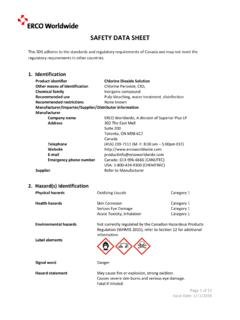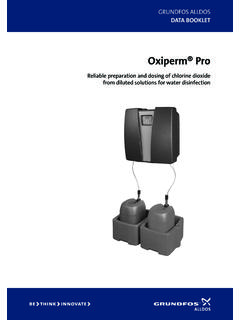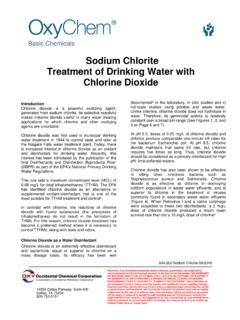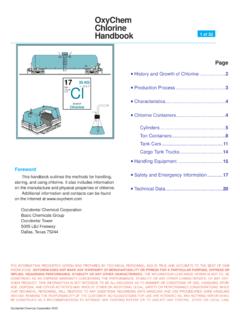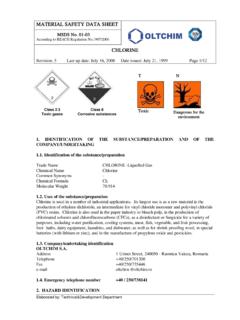Transcription of Chlorine Dioxide, Chlorite and Chlorate in Drinking …
1 WHO/FWC/ Chlorine dioxide , Chlorite and Chlorate in Drinking -water Background document for development of WHO Guidelines for Drinking -water Quality This document replaces document reference number WHO/SDE/ World Health Organization 2016 All rights reserved. Publications of the World Health Organization can be obtained from WHO Press, World Health Organization, 20 Avenue Appia, 1211 Geneva 27, Switzerland (tel.: +41 22791 3264; fax: +41 22 791 4857; email: Requests for permission to reproduce or translate WHO publications whether for sale or for non-commercial distribution should be addressed to WHO Press at the above address (fax: +41 22791 4806; email: The designations employed and the presentation of the material in this publication do not imply the expression of any opinion whatsoever on the part of the World Health Organization concerning the legal status of any country, territory, city or area or of its authorities, or concerning the delimitation of its frontiers or boundaries.))
2 Dotted lines on maps represent approximate border lines for which there may not yet be full agreement. The mention of specific companies or of certain manufacturers products does not imply that they are endorsed or recommended by the World Health Organization in preference to others of a similar nature that are not mentioned. Errors and omissions excepted, the names of proprietary products are distinguished by initial capital letters. All reasonable precautions have been taken by the World Health Organization to verify the information contained in this publication. However, the published material is being distributed without warranty of any kind, either expressed or implied. The responsibility for the interpretation and use of the material lies with the reader.
3 In no event shall the World Health Organization be liable for damages arising from its use. The named authors alone are responsible for the views expressed in this publication. iii Preface Access to safe Drinking -water is essential to health, a basic human right and a component of effective policy for health protection. A major World Health Organization (WHO) function to support access to safe Drinking -water is the responsibility to propose .. regulations, and to make recommendations with respect to international health matters .. , including those related to Drinking -water safety and management. The first WHO document dealing specifically with public Drinking -water quality was published in 1958 as International Standards for Drinking -water. It was subsequently revised in 1963 and in 1971 under the same title.
4 In 1984 1985, the first edition of the WHO Guidelines for Drinking -water Quality (GDWQ) was published in three volumes: Volume 1, Recommendations; Volume 2, Health criteria and other supporting information; and Volume 3, Surveillance and control of community supplies. Second editions of these volumes were published in 1993, 1996 and 1997, respectively. Addenda to Volumes 1 and 2 of the second edition were published in 1998, addressing selected chemicals. An addendum on microbiological aspects reviewing selected microorganisms was published in 2002. The third edition of the GDWQ was published in 2004, the first addendum to the third edition was published in 2006 and the second addendum to the third edition was published in 2008.
5 The fourth edition was published in 2011, and the first addendum to the fourth edition was published in 2017. The GDWQ are subject to a rolling revision process. Through this process, microbial, chemical and radiological aspects of Drinking -water are subject to periodic review, and documentation related to aspects of protection and control of Drinking -water quality is accordingly prepared and updated. Since the first edition of the GDWQ, WHO has published information on health criteria and other supporting information to the GDWQ, describing the approaches used in deriving guideline values and presenting critical reviews and evaluations of the effects on human health of the substances or contaminants of potential health concern in Drinking -water.
6 In the first and second editions, these constituted Volume 2 of the GDWQ. Since publication of the third edition, they comprise a series of free-standing monographs, including this one. For each chemical contaminant or substance considered, a background document evaluating the risks for human health from exposure to the particular chemical in Drinking -water was prepared. The draft health criteria document was submitted to a number of scientific institutions and selected experts for peer review. The draft document was also released to the public domain for comment. Comments were carefully considered and addressed as appropriate, taking into consideration the processes outlined in the Policies and Procedures Used in Updating the WHO Guidelines for Drinking -water Quality ( ) and the WHO Handbook for Guideline Development ( ), and the revised draft was submitted for final evaluation at expert consultations.
7 During the preparation of background documents and at expert consultations, careful consideration was given to information available in previous risk assessments carried out by the International Programme on Chemical Safety, in its Environmental Health Criteria monographs and Concise International Chemical Assessment Documents, the International Agency for Research on Cancer, the Joint Food and Agriculture Organization of the United Nations (FAO)/WHO Meeting on Pesticide Residues and the Joint FAO/WHO Expert Committee on Food Additives (which evaluates contaminants such as lead, cadmium, nitrate and nitrite, in addition to food additives). Further up-to-date information on the GDWQ and the process of their development is available on the WHO website and in the current edition of the GDWQ.
8 Iv Acknowledgements The first draft of Chlorine dioxide , Chlorate and Chlorite in Drinking -water, Background document for development of WHO Guidelines for Drinking -water Quality was prepared by Dr Joseph Cotruvo, Joseph Cotruvo & Associates and NSF International WHO Collaborating Centre, United States of America (USA), and Professor Fawell, United Kingdom, to whom special thanks are due. The work of the following experts was crucial in the development of this document and others in the first addendum to the fourth edition: Dr M. Asami, National Institute of Public Health, Japan Dr Bevan, Cranfield University, United Kingdom Dr J. Cotruvo, Joseph Cotruvo & Associates and NSF International WHO Collaborating Centre, USA Dr A. Eckhardt, Umweltbundesamt (Federal Environment Agency), Germany Professor Fawell, United Kingdom Ms M.
9 Giddings, Health Canada, Canada Dr A. Hirose, National Institute of Health Sciences, Japan Dr P. Marsden, Drinking Water Inspectorate, United Kingdom Professor Y. Matsui, Hokkaido University, Japan Dr Meek, University of Ottawa, Canada Dr E. Ohanian, Environmental Protection Agency, USA Professor Ong, National University of Singapore, Singapore Dr S. Ramasamy, Environmental Protection Agency, USA Professor S. Snyder, University of Arizona, USA The draft text was discussed at the expert consultations for the first addendum to the fourth edition of the GDWQ, held on 2 5 December 2013 and 23 26 February 2015. The final version of the document takes into consideration comments from both peer reviewers and the public. The coordinator was Ms J. De France, WHO Headquarters, with support from Mr P.
10 Callan, Australia. Strategic direction was provided by Mr B. Gordon, WHO Headquarters. Dr A. Tritscher and Dr P. Verger, WHO Headquarters, provided liaisons with the Joint FAO/WHO Expert Committee on Food Additives and the Joint FAO/WHO Meeting on Pesticide Residues, while Dr R. Brown and Ms C. Vickers, WHO Headquarters, provided liaisons with the International Programme on Chemical Safety. Dr M. Perez contributed on behalf of the Radiation Programme, WHO Headquarters. Dr R. Yadav, WHO Headquarters, provided input on pesticides added to Drinking -water for public health purposes. Ms P. Ward and Ms L. Robinson provided invaluable administrative support at the expert consultations and throughout the review and publication process.











